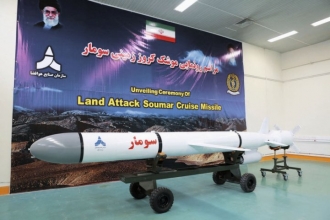TEL-AVIV—Iran has unveiled a domestically produced long-range land attack cruise missile, dubbed Soumar.
Based on the Russian Kh-55, the Soumar is believed to have a range of at least 2,000 km. “This missile represents a significant leap in the Middle East arms race,” says Col. Aviram Hasson of Israel’s Missile Defense Organization.
“It positions Iran among the world’s leaders in missile technology,” a Western intelligence source adds.
Iranian defense minister Hussein Dehghan presented the new surface-to-surface missile on March 8 as an “effective step” in boosting the country’s defense and deterrence capabilities. Dehghan described the Soumar as capable of hitting long-range targets with “high accuracy, while evading enemy counter-measures.” Western intelligence sources noted that the missile’s warhead appears smaller than the Russian original and is incapable of carrying a nuclear device. Iranian media reported that the missile completed its testing and is now in serial production.
It has been 14 years since Iran managed to procure six Russian Kh-55 (NATO: ‘Kent’, AS-15A) air-launched cruise missiles from Ukraine. According to a Ukrainian Attorney General statement, released in 2005, the missiles were smuggled outside the country by senior officials of Ukrainian State’s UkrSpetzExport organization in 2000. While most of the Ukrainian arsenal of hundreds of Kh-55s was destroyed or transferred to Russia, six missiles were sold to China and six to Iran in a breach of a Ukrainian-Russian agreement and the Missile Technology Control Regime (MTCR). The missiles, originally designed to be launched from a Tupolev Tu-160 aircraft, were delivered to Iran without the Ukranian R95-300 turbofan engine and without the original terrain counter matching (TERCOM) navigation system.
Iran secretly received the missiles in the first half of 2001 and began reverse engineering work. But unlike its publicly displayed ballistic missile program, Iran did not admit to having a cruise missile program until 2012. At that time, it displayed a prototype dubbed Meshkat (flashlight), declaring it has a range of 2,000 km. Iran has said it also developed an indigenous turbofan engine for the missile. The six Soumar missiles revealed now are equipped with an engine with very close resemblance to the Ukrainian R95. This might suggest that Iran has acquired turbofan engines separately from the missiles. Unlike the Russian original, the Soumar’s engine is not pulled out from the missile’s body, but installed externally on it.
Western intelligence officials, who examined footage of the Soumar released by Iranian television, have found the missile to be a little longer than 6 meters, with the original diameter of 20.2”. Its full weight is 1,210 kg, or 1,530 kg with the booster rocket. The warhead appears to weigh 150-170 kg, which makes it incapable of carrying a nuclear weapon. Its maximum cruise speed is estimated at Mach 0.7, and the radar-cross section appears larger than the Tomahawk’s.
No sensor is installed in the missile’s nose, which means it is guided by a GPS/INS navigation system. Therefore, its accuracy is estimated at about 50 meters. “It is equipped with a Doppler-pulse radar, which compares measurements to a pre-programmed map, enabling it to follow the terrain at an altitude of 300 ft. in the last stages of flight,” an intelligence official says.
Named for the town that suffered an Iraqi chemical weapons attack during the Iran-Iraq war, the Soumar was displayed with a ground launcher. As the missile is ejected from the canister, three aerodynamic navigation winglets unfold as well as four “tennis-bat” shaped stabilizing winglets. Following the burn of the rocket booster, the missile appears to stabilize in a horizontal flight, constantly ascending to cruise altitude. The cruise flight is navigated through pre-programmed way points, and as it approaches the target area, the Soumar performs a pop-up maneuver and dives towards the target.
“The Iranian engineers attempted to stick as much as possible to the original Ukrainian design,” said the intelligence source. “Yet, the missile’s systems demonstrate remarkable technological capabilities.”
The new missile is raising concerns in Israel, Iran’s arch-enemy. Asked whether Israeli missile defense systems are prepared to deal with such a cruise missile, Hasson said: “I would not comment on our current capabilities.” Israel is developing the David’s Sling missile defense system, designed to counter heavy rockets as well as cruise missiles. “We will conduct two extensive test series of the David’s Sling this year,” said Hasson. “By the end of the year, David’s Sling will have initial operational capability.”







